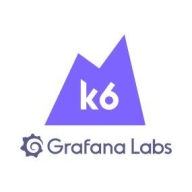


Find out what your peers are saying about Apache, Tricentis, Perforce and others in Load Testing Tools.



Load Impact offers three main features:
OpenText Enterprise Performance Engineering (LoadRunner Enterprise) provides robust performance testing capabilities with scalable and user-friendly tools. It supports multiple protocols for diverse applications, ensuring reliable and comprehensive performance metrics for organizations.
Designed for extensive performance testing, OpenText Enterprise Performance Engineering offers advanced integration features and global testing capabilities. Users value its ease of scheduling, detailed analysis, and efficient resource management. It simulates real-world scenarios to deliver valuable metrics across industries. Its intuitive interface, while needing smoother navigation, aligns with its flexibility and versatility. Enhanced reporting and cloud-based integration, especially with AWS, are potential growth areas alongside improved third-party tool integration and technical support.
What are the key features of OpenText Enterprise Performance Engineering?OpenText Enterprise Performance Engineering is implemented in banking, healthcare, and retail industries, assisting in load, stress, and performance testing. Organizations utilize its capabilities for validating web, API, cloud, ERP, and Citrix applications, ensuring reliability with comprehensive metrics for large-scale user handling.
OpenText Professional Performance Engineering, known as LoadRunner Professional, stands out with its powerful scripting tool, flexible capabilities, and extensive analytics, supporting numerous concurrent users for impactful load testing.
This performance engineering tool offers integration across systems and strong community support, paired with user-friendly interfaces. It excels in features like multi-protocol support, auto-correlation, and detailed reporting. However, improvements are needed in user-friendliness and cost-effectiveness, as scripting remains complex and pricing is a hurdle. Enhancing mobile and SPA testing capabilities, modern protocol support, and compatibility with non-Windows platforms would greatly benefit users while expanding monitoring and technical support responsiveness.
What are the key features of OpenText LoadRunner Professional?LoadRunner Professional is employed for performance and load testing across sectors such as banking, hospitality, and telecommunications. Users simulate business transactions and test applications under different user loads, focusing on API testing, web applications, and benchmarking to achieve optimal performance in complex scenarios.